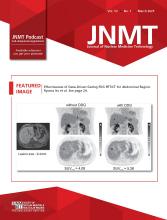Abstract
When unexpected results are obtained with standard image collection, the nuclear medicine physician must consider many technical factors that may have contributed. When image quality is poor, prior radiotracer administration, among other things, should always be considered. Our case demonstrates how knowledge of patient history and basic principles of nuclear medicine physics allows recognition of the septal penetration artifact. This allows the nuclear medicine physician to tailor the exam to an individual patient and obtain the most useful diagnostic information for the clinician.
Footnotes
Published online ▪▪▪▪▪▪▪▪▪▪▪▪.







